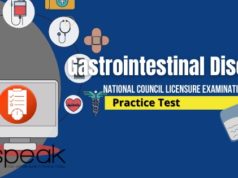1. Answer: B. Give after a high carbohydrate meal – It is recommended that paracetamol should not be taken after a high carbohydrate meal since it reduces the absorption rate.
2. Answer: B. Taking it with coffee – Taking Betamethasone with caffeine may decrease its absorption.
3. Answer: A. NSAIDS – NSAIDS would increase the likelihood of lithium toxicity.
4. Answer: B. Mefenamic Acid – NSAIDS would increase the effect of phenytoin. The choices were all pain relievers, however, NSAIDS have this action.
5. Answer: C. Teach her to drink Vitamin C – Vitamin C can encourage stone formation in the kidney
6. Answer: A. Hold the medication and refer to the physician – Uric acid is expected to be normal less than or equal to 6 mg/dL. Yellowish discoloration of skin signals a problem on liver function
7. Answer: A. Hold the earlobe up and back – Make the adult patient lie on his back and hold the earlobe up and back. Anatomically, the adult’s inner ear coil more than the inner ear of a pediatric patient.
8. Answer: D. – A high carbohydrate diet with high protein content is not an appropriate health teaching since it makes the kidneys to work harder in screening the large molecules of proteins. The goal is to reduce the workload of the kidneys in order to prevent further damage. Eating a low salt diet, high carbohydrate and low in protein meals as well as fluid restriction are the steps in maintaining the kidney function.
9. Answer: A. – Therapeutic communication using listening skills is a very important factor in helping the significant others to adjust to the situation. Be the source of the information and listen to them rather than blocking them. Empathy is also essential in order to see the needs of the patient as well as his wife. Other items were not correct since it pose judgemental comments rather than understanding.
10. Answer: C. – A common reason for an increase in BUN is dehydration. The nurse should consider the BUN level, along with the patient’s vital signs, intake and output, weight, and skin turgor as potential indicators of dehydration. Because an increased BUN may also be caused by anything that causes poor renal perfusion or renal dysfunction, it is important to look at the BUN in relation to the pathological process for the individual patient.
11. Answer: B. Eosinophils – This is used in order to determine allergy, drug reactions, Hodgkin’s disease. In Cushing’s syndrome, it is expected to decrease.
12. Answer: C – A pre-diabetic patient is expected also the have elevated blood pressure levels. This is a normal blood pressure.
13. Answer: D. Refer to the physician – This is the right nursing action since it is the duty of the physician to make a medical diagnosis. A collaborative approach must be taken into consideration.
14. Answer: D. Neuropathy – One of the major complications in a diabetic patient. It is a loss of function of the nerves that would conduct nerve impulses. Neuropathy can have symptoms such as loss of sensation, paralysis, tingling, and burning pain.
15. Answer: A. Eye Examination – An annual check-up of the eyes can also prevent or minimize the blurring of vision. Antiplatelet therapy can be done continuously while HbA1C is advised to be checked twice a year. Self-monitoring of blood glucose can be done every day.
16. Answer: B. MRI – Magnetic Resonance Imaging can be done in order to check for the old and new infarcts.
17. Answer: C. Smoking – According to research smoking is the leading cause of stroke. Smoking can allow plaques to form inside the arterial wall making it harder to allow good circulation around the brain.
18. Answer: C
19-20. Renzo is a laborer in a construction company. He consulted the company clinic one day, he complained of back pain for several days. The doctor instructed him to take Mefenamic Acid 500mg every 4 hours for back pain. He further advised Renzo to come back if the pain persists after three days.
19. Answer: B. Acute pain related to physical exertion – One day 1, this is the appropriate nursing diagnosis for the case. Other items were also related however at the moment it does not answer what is being asked.
20. Answer: C. – Am MRI with gadolinium is a common contrast media in order to visualize the internal body structures. These agents would work with magnetic fields.
21. Answer: D. Echopraxia – This is a kind of movement wherein the patient involuntarily imitates the movement of the other person.
22. Answer: C. Cold Weather – The following items involves the use of energy as well as movements of the body. Anything that can add stress to the body can affect the normal functioning of the nerves especially in the case of Multiple Sclerosis.
23. Answer: B. T cells – T-cells have an important role during the inflammation of the central nervous system. It combats the foreign entity inside the body. However, in the case of multiple sclerosis, as it is believed to be an autoimmune disease, the T-cells could not recognize the cells that they destroy; they might also destroy the myelin sheath that is not a foreign entity.
24. Answer: B. Traumatic Brain injury -. Multiple sclerosis can run into a family when a complete assessment is done. Some instances can also be pointed out as a result of a severe viral infection or vitamin D deficiency.
25. Answer: B. Provide steps to prevent infecting others – Multiple Sclerosis is not a communicable disease. It is thought to be autoimmune and the results of having such illness are impaired physical mobility. The goals in nursing care are concentrated on providing a safe environment as well as give the needed assistance in performing the activities of daily living.








Thanks,so greatfull waooo,I really enjoy this.be bless and continue helping us! God will reward.
Why can’t i view the questions??? 🙁